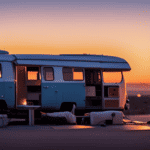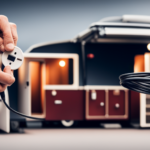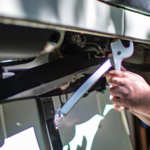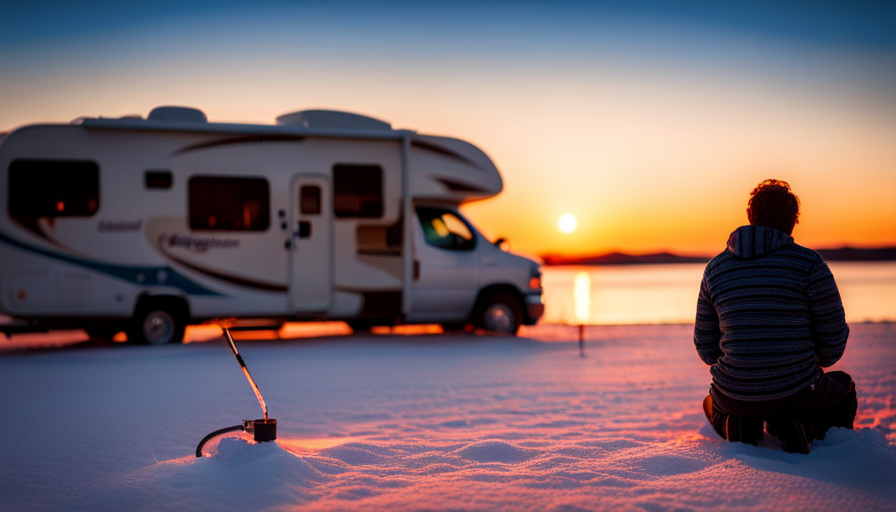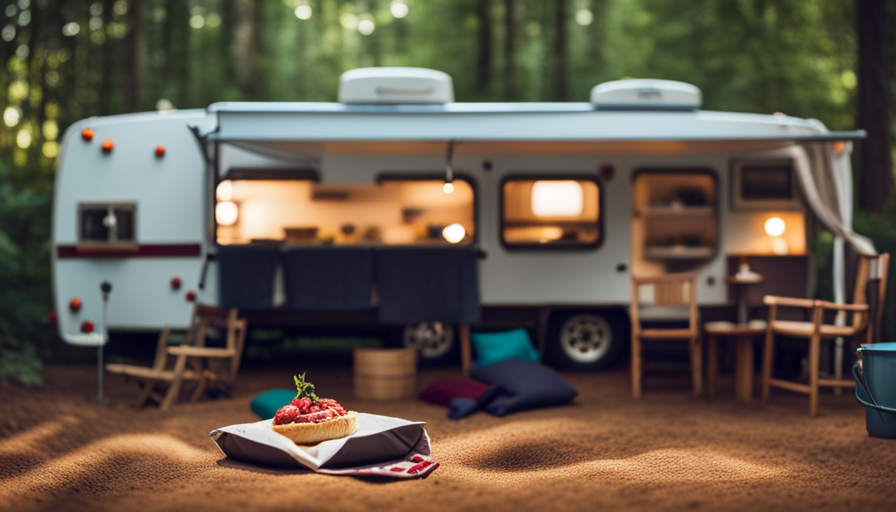Imagine getting ready for an adventurous trip, only to discover that your RV isn’t getting any power when plugged in. It’s like being stranded in a desolate location with no gas in the tank. But fear not, because I’m here to help you troubleshoot and resolve this frustrating issue.
In this article, we’ll explore the possible causes and solutions for your powerless camper, using a technical and precise approach. We’ll start by checking the power source and inspecting the electrical system, ensuring everything is in working order. Then, we’ll test the power cord and check the battery to rule out any potential problems.
Additionally, we’ll verify the RV’s power converter and suggest seeking professional help if needed. We’ll also consider external factors that may affect the camper’s power supply and discuss backup power options. Finally, we’ll wrap up with preventative measures to avoid future power mishaps.
So let’s dive in and bring the energy back to your camper!
Key Takeaways
- Troubleshoot the power source and electrical system to identify the cause of the power issue.
- Test the power cord and battery for any damages or issues.
- Verify the functionality of the RV’s power converter and check its wiring.
- Consider external factors such as faulty campground connections or power outages that may be affecting the power supply.
Check the Power Source
Check if you’ve got power flowing to your camper when it’s plugged in. Troubleshooting steps can help identify common power issues that may be causing the problem.
Begin by checking the power source to ensure it’s functioning properly. Start by inspecting the electrical outlet where the camper is plugged in. Check if there’s power by using a multimeter or a voltage tester. If there’s no power, check the circuit breaker or fuse box to see if a breaker’s tripped or a fuse’s blown. Reset the breaker or replace the fuse if necessary.
If there’s power at the outlet, move on to inspecting the power cord and the connections between the camper and the power source. Look for any signs of damage or loose connections. Make sure the cord’s securely plugged into both the camper and the outlet. If everything appears to be in good condition, it may be necessary to check the electrical system within the camper itself.
By following these troubleshooting steps, you can determine if the power issue lies in the power source or within the camper’s electrical system. Inspecting the electrical system will help further diagnose and resolve the problem.
Inspect the Electrical System
Take a moment to examine the electrical system and you’ll quickly see how easily you can resolve any issues. Common electrical issues in campers can range from a blown fuse to a faulty connection. To troubleshoot power problems in your camper, start by checking the circuit breaker panel. Make sure all the breakers are in the correct position and not tripped.
If everything looks fine there, move on to inspecting the power cord. Look for any signs of damage such as frayed wires or burnt areas. Additionally, check the connections at both ends of the power cord to ensure they’re secure. If the cord appears to be in good condition, try plugging it into a different power source to see if that resolves the issue.
If you still have no power, it may be necessary to consult a professional electrician for further assistance. Transitioning into the next section, testing the power cord will help determine if that’s the source of the problem.
Test the Power Cord
Examine the power cord to determine if it is functioning properly and securely connected. Testing the power cord is crucial when troubleshooting a camper that has no power when plugged in. To ensure that the power cord is not the source of the problem, follow these steps: First, visually inspect the power cord for any fraying or damage. Next, check the connection to the camper’s electrical system, ensuring that it is secure and free from corrosion. Finally, consider testing the power cord by turning on hot water heater to see if it is delivering power to the camper. If the hot water heater is not functioning, it may indicate an issue with the power cord. If the power cord is found to be faulty, it should be replaced immediately to prevent any potential safety hazards.
| Test the Power Cord | Check the Power Outlet |
|---|---|
| Inspect the outer insulation of the power cord for any visible damage, such as cuts or fraying. Ensure there are no exposed wires. | Plug another device into the same power outlet to verify that it is working correctly. |
| Use a multimeter to test the continuity of the power cord. Set the multimeter to the resistance setting and touch one probe to each end of the power cord. A reading of zero indicates that the power cord is intact. | Check for any loose connections or burnt marks in the power outlet. Ensure that the outlet is receiving power by using a voltage tester. |
By testing the power cord and checking the power outlet, you can identify if the issue lies with the cord or the outlet. Once you have determined that the power cord is functioning properly and the outlet is providing power, you can move on to the next step of checking the battery.
Check the Battery
When checking the battery, I’ll first inspect it for any signs of corrosion or loose connections. Corrosion can hinder the battery’s performance, while loose connections can result in a lack of power.
Next, I’ll test the battery’s voltage to ensure it’s charged. This will help determine if the battery’s the cause of the camper’s power issue.
Inspect the battery for any corrosion or loose connections
Don’t even think about skimping on the joy of investigating that battery for corrosion or any sneaky loose connections. It’s essential to inspect the battery connections thoroughly to ensure they’re secure and free from any buildup or damage.
Start by visually examining the battery terminals for signs of corrosion, such as a white powdery substance. If corrosion’s present, gently clean the terminals using a battery terminal brush and a mixture of baking soda and water. Be sure to disconnect the battery before cleaning to avoid any accidental electrical shocks.
Additionally, check for any loose connections and tighten them if necessary.
Once the battery connections are clean and secure, we can move on to the next step of testing the battery’s voltage to ensure it’s charged and ready to power your camper.
Test the battery’s voltage to ensure it is charged
To truly experience the full potential of your adventure, you’ll want to make sure you check the battery’s voltage to ensure it’s fully charged and ready to ignite your journey. Testing the battery’s voltage is crucial to determine its health and troubleshoot any potential issues with the electrical system.
Here is a visual representation of the steps to test the battery’s voltage:
- Gather a multimeter and set it to the DC voltage setting.
- Connect the red probe to the battery’s positive terminal and the black probe to the negative terminal.
- Read the voltage displayed on the multimeter.
- If the voltage is below 12.6 volts, the battery may need charging or replacement.
- If the voltage is above 12.6 volts, the battery is likely in good health.
By testing the battery’s voltage, you can diagnose any problems with the camper’s power supply. This will lead us to the next step of verifying the RV’s power converter.
Verify the RV’s Power Converter
Check if the RV’s power converter is pumping electricity like a heart beating life into the camper. To verify the RV’s power converter, start by checking the electrical wiring. Inspect the wiring for any signs of damage or loose connections. Ensure that all the wires are securely connected to their respective terminals.
Next, troubleshoot the circuit breaker. Locate the circuit breaker panel and examine each breaker to see if any have tripped. If you find a tripped breaker, reset it and monitor if it trips again.
Additionally, test the voltage coming into the converter to ensure it’s within the acceptable range. Use a multimeter to measure the voltage between the converter’s input terminals. The reading should match the manufacturer’s specifications. If the voltage is outside the acceptable range, there may be an issue with the power source.
Finally, consult the owner’s manual for further troubleshooting steps and guidance. The manual will provide specific instructions tailored to your RV’s make and model. Understanding the power converter’s functionality and following the manual’s recommendations will help you diagnose and resolve any power-related issues with your camper.
Consult the Owner’s Manual
Make sure you consult the owner’s manual for detailed instructions on how to address any issues with your RV’s power converter. Troubleshooting tips can vary depending on the specific model and manufacturer, so it is important to refer to the manual for accurate information. However, there are some common power issues that you can check for when your camper has no power when plugged in.
One common issue is a tripped circuit breaker. Check the breaker panel in your RV and make sure all the breakers are in the "on" position. If any of them are tripped, reset them and see if that restores power. Another potential problem could be a blown fuse. Locate the fuse box and check all the fuses to see if any of them are blown. If you find a blown fuse, replace it with a new one of the same amperage.
To help illustrate these troubleshooting tips, refer to the table below:
| Issue | Troubleshooting Step | Solution |
|---|---|---|
| Tripped circuit breaker | Check breaker panel | Reset tripped breaker |
| Blown fuse | Locate fuse box | Replace blown fuse |
If these troubleshooting steps do not resolve the power issue, it may be necessary to seek professional help. A qualified technician will have the expertise to diagnose and repair any complex electrical problems in your RV’s power converter.
Seek Professional Help
If you’re unable to resolve the power issue in your RV, it’s time to seek professional help. When it comes to electrical problems in your camper, it’s crucial to seek expert advice to ensure the issue is properly diagnosed and resolved. Trying to fix the problem yourself without the necessary knowledge and skills can potentially lead to further damage or even personal injury.
Finding professional assistance should be your next step. Look for certified RV technicians or electricians who specialize in RV electrical systems. They have the expertise and tools required to troubleshoot and repair complex electrical problems in campers. They can also provide guidance on preventive maintenance and offer recommendations to avoid similar issues in the future.
It’s important to communicate the details of the problem to the professional you seek assistance from. Provide them with information such as when the issue started, any recent changes or modifications made to the electrical system, and any symptoms or warning signs you’ve observed. This will help them in their diagnosis and ensure a more accurate and efficient resolution.
Consider external factors that may be contributing to the power issue in your RV. Faulty campground electrical connections, low voltage at the RV park, or problems with the power cord or adapter can all cause power problems in your camper. These factors should be evaluated and addressed to avoid further complications.
Consider External Factors
When troubleshooting a camper that has no power when plugged in, it’s important to consider external factors that may be affecting the power supply.
Firstly, check if there are any power outages in the area that could be causing the issue.
Additionally, be aware of any campground restrictions or limitations on power usage that could be impacting the camper’s power supply.
It’s crucial to take these factors into account in order to accurately diagnose and resolve the power issue.
Check if there are any power outages in the area
Hey there, camper! Have you checked if there’s a power outage in your area that might be causing the lack of electricity? Before assuming that your camper is the issue, it’s important to consider external factors that could be affecting the power supply.
Here are some steps you can take to investigate further:
-
Check local weather conditions: Sometimes severe weather conditions like storms or heavy winds can result in power outages. Make sure to stay updated on any weather alerts in your area.
-
Contact campground management: Reach out to the campground staff and inquire if there’ve been any reported power outages or maintenance work that could be impacting the electrical supply.
-
Inspect nearby campers: Take a look at neighboring campers and see if they’re experiencing the same power issues. This could help determine if the problem is isolated to your camper or affecting multiple units.
-
Check local power company: Contact your local power company to see if there’re any reported outages or scheduled maintenance in your area.
-
Utilize backup power sources: If you have access to a generator or an alternative power source, try connecting your camper to it to see if you can restore electricity.
Remember to be aware of any campground restrictions or limitations on power usage. It’s essential to understand the rules and regulations regarding power consumption to avoid any unnecessary problems.
Be aware of any campground restrictions or limitations on power usage
After checking for power outages in the area, it’s important to be aware of any campground restrictions or limitations on power usage. This is crucial because some campgrounds may have specific rules regarding the amount of power that can be used by campers. To help you understand this better, let me provide you with a table that outlines common campground restrictions and power limitations:
| Campground Restrictions | Power Limitations |
|---|---|
| No use of generators | Limited to 30 amps |
| Restrictions on high-power appliances | Limited to 50 amps |
| Time restrictions on usage | Limited to 20 amps |
By knowing these restrictions and limitations, you can adjust your power usage accordingly to prevent any issues with your camper. This will ensure that you can enjoy your camping experience without any power-related problems. Now, let’s move on to the next section and discuss how to plan for backup power options.
Plan for Backup Power Options
When it comes to planning for backup power options, I always make sure to carry a portable generator or solar panels as alternative power sources.
This ensures that I have a reliable source of power in case my camper has no power when plugged in. Additionally, investing in a power inverter to convert DC power to AC power is a smart move, as it allows me to use my camper’s battery to power AC appliances.
Carry a portable generator or solar panels for alternative power sources
If you’re planning on camping off the grid, it’s always a good idea to bring along a portable generator or solar panels as alternative power sources. These options provide a reliable and convenient way to generate electricity for your camper. Here are the pros and cons of each:
-
Portable Generator:nnPros:
-
Provides a high power output, suitable for running multiple appliances simultaneously.
-
Easy to refill with fuel and can be used for an extended period of time.
-
Can be used in any weather condition.nnCons:
-
Generates noise and emits fumes, which may disturb the camping experience.
-
Requires regular maintenance and fuel supply.
-
Solar Panels:nnPros:
-
Environmentally friendly and renewable source of energy.
-
Silent operation and no emissions.
-
Low maintenance requirements.nnCons:
-
Dependent on sunlight availability, limiting power generation during cloudy days.
-
Initial investment cost can be higher than a portable generator.
Considering the pros and cons, it’s important to choose the option that best suits your needs. However, if you want to utilize the existing battery system in your camper, it’s recommended to invest in a power inverter to convert DC power to AC power. This will allow you to use your camper’s battery to run AC-powered appliances.
Invest in a power inverter to convert DC power to AC power
Investing in a power inverter allows you to harness the energy stored in your camper’s battery and use it to power AC appliances. Power inverters are cost-effective options that provide numerous benefits for campers.
Firstly, they allow you to use your camper’s existing battery system to power AC devices, eliminating the need for additional power sources. This saves you money and reduces the need for carrying extra equipment.
Additionally, power inverters provide a reliable and consistent power supply, ensuring that your appliances operate smoothly. They also offer versatility, as they can be used to power a variety of devices such as laptops, TVs, and kitchen appliances.
By using a power inverter, you can enjoy the convenience and comfort of AC power while on the road. Incorporating preventative measures into your camper’s power system is crucial to avoid any power-related issues.
Preventative Measures
To keep your camper’s power flowing smoothly, you’ve got to be proactive and take a few steps to prevent any issues from arising. One of the key ways to ensure a continuous power supply is by investing in backup power options and alternative power sources. These can come in handy when you encounter power outages or when your primary power source fails.
Below is a table outlining some preventative measures you can take to avoid power-related problems in your camper:
| Preventative Measures | Description | Benefits |
|---|---|---|
| Regular maintenance | Conduct routine checks on your camper’s electrical system to identify any potential issues before they become major problems. | Reduces the chances of unexpected power failures |
| Surge protection | Install surge protectors to safeguard your electrical equipment from power surges that can damage sensitive electronics. | Protects your devices from damage |
| Battery monitoring | Keep an eye on your camper’s battery levels and ensure they are properly charged to avoid power depletion. | Maintains a consistent power supply |
By implementing these preventative measures, you can minimize the risk of power-related problems in your camper and enjoy your camping experience without any interruptions. Remember, being proactive is key to ensuring a reliable and uninterrupted power supply in your camper.
Frequently Asked Questions
What are some common external factors that can affect the power supply in a camper?
To troubleshoot power issues in a camper, it’s important to identify common electrical problems. Some external factors that can affect the power supply include faulty campground connections, damaged power cords, or a tripped circuit breaker.
Additionally, insufficient voltage from the power source or a faulty converter can also cause power problems. To address these issues, you should check the campground connections, inspect the power cords for any damage, reset the circuit breaker, and ensure the converter is functioning properly.
Are there any preventative measures that can be taken to avoid power issues in a camper?
To maintain a consistent power supply in a camper and prevent frustrating power outages, it’s crucial to take proactive measures. Regularly inspecting and maintaining the electrical system is key. This involves checking the battery, ensuring proper connections, and inspecting cables for any signs of wear or damage.
Additionally, investing in a surge protector and voltage regulator can safeguard against unexpected power surges. By prioritizing preventive maintenance, you can ensure a reliable power supply during your camping adventures.
What are some backup power options available for campers?
Backup power options for campers include portable generators. These generators can provide a reliable source of electricity when there’s no power available or when the camper’s power supply isn’t working. Portable generators are designed to be easily transported and can be powered by gasoline, propane, or diesel. They come in various sizes and power outputs, allowing campers to choose the one that best suits their needs.
Should I consult the owner’s manual if my camper is experiencing power issues?
Consulting the owner’s manual is crucial when troubleshooting power problems in a camper. The owner’s manual contains valuable information about the electrical system, including diagrams, troubleshooting tips, and specific instructions for your camper model. It provides a comprehensive guide to understanding and resolving power issues, ensuring you can address the problem efficiently and effectively.
Don’t overlook the importance of the owner’s manual—it’s the key to resolving power problems and enjoying a hassle-free camping experience.
When is it necessary to seek professional help for power problems in a camper?
When it comes to power problems in a camper, it’s necessary to seek professional help when troubleshooting methods fail to resolve the issue. Professional help should be sought when the problem is beyond the scope of basic troubleshooting, such as checking fuses and connections.
Electrical issues can be complex and potentially dangerous, so it’s important to have a trained professional diagnose and repair the problem to ensure the safety and functionality of the camper’s power system.
Why Is My Camper Battery Not Charging When Plugged In?
If you’re facing a troubleshooting camper battery charging issue where your battery is not charging when plugged in, there could be a few reasons for it. It might be due to a faulty connection, a blown fuse, or a malfunctioning charging system. It’s essential to inspect and test each component to identify the exact cause and address it accordingly.
Conclusion
In conclusion, troubleshooting a camper’s power issues requires a systematic approach. By checking the power source and inspecting the electrical system, one can identify and resolve the problem effectively. Testing the power cord and verifying the RV’s power converter are also important steps. Seeking professional help is advisable for complex issues. Considering external factors such as weather conditions and campground amenities is crucial as well. Additionally, planning for backup power options and implementing preventative measures will ensure a smooth camping experience. As they say, "An ounce of prevention is worth a pound of cure."






